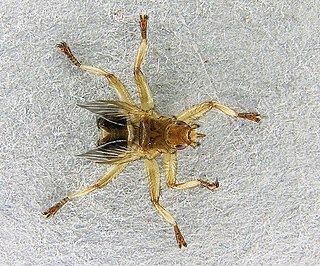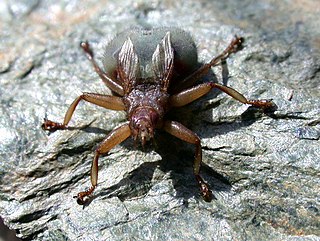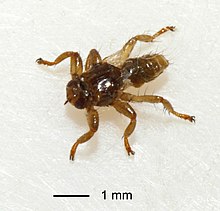
Hippoboscidae, the louse flies or keds, are obligate parasites of mammals and birds. In this family, the winged species can fly at least reasonably well, though others with vestigial or no wings are flightless and highly apomorphic. As usual in their superfamily Hippoboscoidea, most of the larval development takes place within the mother's body, and pupation occurs almost immediately.

Lipoptena cervi, the deer ked or deer fly, is a species of biting fly in the family of louse flies, Hippoboscidae. These flies are commonly encountered in temperate areas of Europe, Siberia, and northern China. They have been introduced to North America. They are parasites of elk, deer, and other deer family members, burrowing through the fur and sucking the blood of the host animals. Adults are only 5–7 mm (0.20–0.28 in) in length and brownish in colour. Their bodies are flat and elastic, making their removal difficult. L. cervi is a poor flier and can only fly for short distances. Once the insect reaches its target, it sheds its wings and starts burrowing through the fur.

Crataerina is a genus of louse flies in the family Hippoboscidae. All are parasites of birds, feeding on the blood of various species of Apodidae (swifts) and Hirundinidae. The genus is sometimes spelled Craterina.

Lipopteninae is a subfamily of the fly family Hippoboscidae. All are parasitic.

Lipoptena depressa, or the Western American deer ked, is species of fly in the family Hippoboscidae. The flies are blood-feeding ectoparasites of mule deer, Odocoileus hemionus and white-tailed deer, Odocoileus virginianus. They are found in the western United States and Canada.
Neolipoptena ferrisi, or the Pacific deer ked, is a species of fly from the family Hippoboscidae. They are blood-feeding parasites of the mule deer - Odocoileus hemionus, the white-tailed deer - Odocoileus virginianus & The Pronghorn - Antilocapra americana. They are found from British Columbia, Canada, to Baja California, Mexico. and Australia.
Neolipoptena is a genus of flies in the family Hippoboscidae.

Hippobosca is a genus of flies in the family Hippoboscidae. There are seven known species. There are numerous synonyms.

Pseudolynchia canariensis, the pigeon louse fly or pigeon fly, is a species of biting fly in the family of louse flies, Hippoboscidae.

Pseudolynchia are genus of biting flies in the family of louse flies, Hippoboscidae. There are 5 known species. One of the more well known species is the pigeon louse flyPseudolynchia canariensis. All species are parasites of birds.
Microlynchia is a genus of biting flies in the family of louse flies, Hippoboscidae. There are four known species. All species are parasites of birds. Microlynchia differs from Pseudolynchia in the presence of minute ocelli and a differently shaped scutellum.

Icosta are genus of biting flies in the family of louse flies, Hippoboscidae. There are 52 known species, making it the largest Hippoboscid genus. All species are parasites of birds.
Myophthiria is a genus of biting flies in the family of louse flies, Hippoboscidae. There are 13 known species. All species are Parasites of birds.

Ornithomyinae is a subfamily of the fly family Hippoboscidae. All are blood feeding parasites, for the most part on birds, though some have mammals as hosts.
Strongygaster is a genus of flies in the family Tachinidae.

The Milesiini is a large and diverse tribe of hoverflies. They mimic wasps or hornets.
Microsoma is a genus of flies in the family Tachinidae.
Lasiopa is a genus of flies in the family Stratiomyidae.
Syllegomydas is a genus of flies in the family Mydidae.
Lipoptena grahami is a species of fly in the family Hippoboscidae.









